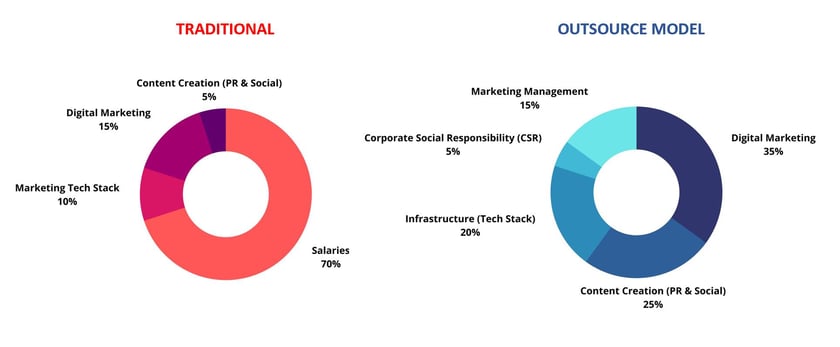B2B Marketing Spend
The following article discusses:
- What elements are Sales, Marketing and Business Owners needing to consider when establishing marketing budgets.
- In a disruptive world, can sales and marketing budgets be agile enough to cope or do they need to be disruptive in their construction and execution.
- A paradigm shift in sales and marketing budgets.
Sheer necessity in most cases has resulted in a further shift in the dynamics of Sales and Marketing! Business leaders can no longer simply talk about agility, they have to demonstrate it. Most businesses have been disrupted both nationally and globally, with Executive Leaders paying closer attention to macro and micro business environments.
Despite the current conditions, leaders still need to plan for the future and this includes establishing budgets for the new world. In a world of constant flux, how should sales and marketing leaders proportioning their budgets for the coming year?
After speaking with many Sales, Marketing and Business Leaders, the typical marketing budget would include a proportion of; Salaries, Inbound and Outbound Marketing depending on the industry/sector. Since the pandemic, not unsurprisingly budgets were either cut or reallocated to predominantly digital marketing and e-commerce. Typical marketing budgets over the past 12 months have been proportioned as follows;
-
50%-70% Salaries leaving the rest of the marketing spend at 30% spread across different marketing elements including;
-
15% Digital (website/ecommerce, search engine optimisation, paid),
-
5% Content, social and PR
-
10% Marketing tech stack (CRM, Automation, tools)
(note: These averages are taken across a wide range of B2B companies and sectors).
With the shift to digital and a greater need for data driven marketing, where should your marketing budget allocation be spent? The following is from conversations with sales, marketing and business leaders.

Let's Get Digital
According to the latest Brand Recruitment Research, which surveyed a good cross-section of sales and marketing leaders, as high as 80% of professionals said they would be investing more into digital marketing specialisms, including;
- SEO (Search Engine Marketing)
- CRM and automation tools
- Social media and content
The ability to measure marketing and its return on investment has always been a priority to business leaders, then it is no wonder why digital marketing spend is the preferred option. However, what Secret Source have witnessed is that in the clamber to switch from traditional to more digital activities, costs have also increased. Competing for good quality people, training, infrastructure and the cost to compete in a digital marketplace with companies vying for the same territory, have pushed up paid or sponsored content costs. This is not likely to subside anytime soon, which is why sales and marketing leaders will also need to think disruptively into ways they can increase their activity, whilst keeping down their overheads. Digital marketing is taking up a large proportion of the budget estimated as high as between 15%-30%
The Costs of Content
'Content is king' was a term being used pre-pandemic, but even more so, content marketing has become a battleground to achieve a share of voice in the marketplace. Generating good quality or engaging content is not a short term activity. If content is to be educational, engaging, and informative, able to convert your audience into customers, then careful planning, execution and budget is required. Costs attributed to Content marketing have increased with companies undecided whether to choose in-house content writers (including social media talent) or external specialists such as freelances or agencies. Good content takes time, time is money, therefore, allocation to quality content is a better investment than quantity on the whole.
Secret Source Marketing have witnessed a definite need for content writers to become more digitally savvy and digital marketing professionals to respect the content process. Cross pollination of the 'two brains' has resulted in marketing teams working closer together in a world that is promoting physical social distancing. Good quality content produced by professionals who can correctly engineer effective content, time after time, is worth investing in. Having this resource in-house can take up 30% of your overall budget compared to 15% of budget working with a team of professionals in relevant sectors.
"In a world of social distancing, has there ever been a greater need for sales and marketing teams to work together" Secret Source Marketing
Talking and moving content!
Secret Source see an increase in investment of video and media content, rather than an ad hoc, separate, non-integrated budget line. The allocation would ideally fall in line with the content marketing budget to give video/media assets' direction and strategy. This is widely outsourced to third parties professionals but still needs careful co-ordination from internal sales and marketing personnel. While filming has been restrictive during the pandemic, there has been increased spend in many sectors for video, animation media.
Employee Costs/Salaries
One of the highest costs of any marketing spend is marketing salaries. With marketing salaries ranging from a junior role at £18,000 to a senior marketing leader at £100,000+ costs for people, despite the pandemic are stable according to research carried out by marketing recruitment agencies. Business commentators suggest B2B organisations are to a certain extent less fragile compared to B2C environments. With the mixture of the skills required within marketing, the pressure on a small in-house marketing team to juggle general and specialist activities, then it is no wonder internal marketing professionals become overwhelmed, jaded or simply turn into project co-ordinators, with little time for strategy or creativity. Experienced B2B marketing talent costing between £30,000-£60,000, means a team required to grow a business can cost upwards of £150,000 (excluding the total lifetime costs of an employee). Businesses will spend 2/3 of their allocated budget on resources to manage the budget and external specialisms.

Secret Source believe that more long term thinking of salary budgets is required. With the ideal objective of being able to utilise top talent, as and when you need it. As a result we have witnessed an increase in many freelance platforms to help facilitate this, with varied marketing skills available. With people located around the world, allos companies to a good choice of talent. The challenge comes from knowing who to use and co-ordinating the activity.
The alternative is to use an agency and hiring amongst agencies during the global pandemic actually increased as a result. Agencies also come with different strengths; creative, digital and public relations as a few examples. So the need to budget for a few agencies is important. Spend on agencies can therefore get expensive, running internal resource to co-ordinate specialists.
With overall marketing spend on internal talent as high as 70%, this weighting of budget leaves little other investment on other activities. With businesses re-shaping organisational structures, there is an opportunity to re-evaluate marketing spend.

Marketing infrastructure
Investment in the sales and marketing tech stack also needs to be re-addressed. Different ways of working, collaboration tools, project management, digtial reporting, research capabilities (read 7 Sales & Marketing Trends), CRM and automation. In order to stay agile, continual investment within your marketing infrastructure is advisable. Reviewing reputable sales and marketing SaaS tools, like Hubspot, SFDC as examples will help track the return on investment of the rest of your marketing spend (Read '8 Reasons Why Using Hubspot CRM Might Be a Good Idea For Your Business').

The Brand Starts at Home
Allow for Sales and Marketing budget allocations for internal marketing. The coming together, albeit virtually, of work colleagues has been an important element of high performing cultures. During the pandemic, many companies have enhanced their profile by investing and communicating their internal brand positively to the outside world. Corporate Social Responsibility (CSR) is viewed and recognised by prospective customers and business partners, who are looking for alignment with their own culture. The result of this has been strong collaboration within vertical sectors. Budgets for internal marketing often sits beneath different departments, such as Human Resources. Some businesses are lucky to have a CSR leader or internal communication teams, but for many businesses, finding time, and budget, to invest close to home is ad hoc. Assigning a proportion of your marketing budget towards internal activities is also a good investment in the short, medium and long term.
How Should I Proportion My Budget?
What is the answer to budget allocation in 2021? While we are not going to dictate how you spend your budget. Market conditions, competitive landscape and sales targets are all dependent variables that would need to be understood, however, a healthy marketing spend budget would focus on Inbound Marketing, generating good quality content/media/social assets that help your prospects on a journey in becoming a customer and beyond. Content marketing should look to be between 10%-20%. Digital Marketing investment is closely linkedin to the above content allocation and involves SEO, SEM and Paid channels. Getting found is important, so this should be set between 30%-40%. Infrastructure investment should be anywhere between 20%-30% depending on where you are on the journey. Your resource budget still remains high at 50%.
Paradigm Shift In Marketing Budgets
Client-side, agency-side, we've been budgeting in B2B for over 20 years! Over this period we have seen some fundamental shifts in activities, processes, allocation and reporting when it comes to budgets. However, during the recent pandemic we are seeing a new paradigm in budgeting, one without physical barriers and culturally more trust in people, processes a less draconian mentality. This is a positive shift, one focussed more on results, data, the right activities, the right skills delivering the right results. The new world has suited the Secret Source Teams very well.
The suggestions to Finance Directors and Executive Leaders is a paradigm shift, one of a high proportion of budget spent on salaries who end up managing external specialists to help them execute, or the alternative of bringing it all in-house and incurring the running costs. Instead Secret Source Marketing suggests you truncate the relationship between in-house marketing, agencies, consultants, freelance and instead having a marketing outsourced team, that evolves as you grow and deploys the neccessary skills to help grow your business. With a predictable cost each quarter and measurable for results. By exchanging salary overheads and re-investing budget spend into your marketing execution could allow you to proportion marketing budgets into a far more growth orientated model.
SSM Paradigm Shift
35% Digital
25% Content (PR, Social and Media)
20% Infrastructure
15% Management
5% Corporate Social Responsibility (CSR)
0% Salary!

The two graphs above show the shift from a traditional marketing budget, heavily weighted on the overhead of internal resource costs, to an integrated mix of marketing activities of which proportions can change to suit the need of the business, with local and global seismic shocks. The outsource model is focussed around activity, execution and measurement, with more time spent on delivery of a clearly defined strategy. Re-deploying traditional budgets typically spent on recruiting, onboarding, nurturing and retaining talent, compared to the outsource model of combining resource with agency, has become more popular for both business leaders and indeed marketing professionals over the last 12 months. The new role of the in-house marketing professional is now sat within the agency and aligned to that of the specialists as an when they are needed to grow the business.

This shift is not a new phenomenon. Culturally it has become more acceptable as people have not been commuting, turning up to a physical place of work every day. Large and small businesses are currently using this model behind the scenes being able to utilise a blue chip marketing department whilst wanting to remain agile in how they budget for it. Emerging out of the pandemic has given Finance, Business Leaders an opportunity to break from the traditional model to a more flexible way of working for the business.
Thinking differently about budgets, the team at Secret Source Marketing work hand in glove with business leaders to help deliver on their marketing operations. If you wanted to discuss further how you disrupt your marketplace by executing at speed whilst managing costs to the business, now is a perfect time to get in contact.
Subscribers also read these articles:
World Book Day
Get To Know Your Customers Day!
Written by Nick Carlson
Nicholas Carlson is a seasoned marketeer with over 25 years of experience driving impactful strategies across a wide range of industries. With a specialism in SaaS, Technology and Professional Services type organisations. As part of the team at Secret Source, he brings deep insight into the evolving landscape of marketing. Nicholas is passionate about partnering with marketing, sales, and business leaders to enhance marketing delivery and fuel sustainable business growth.
